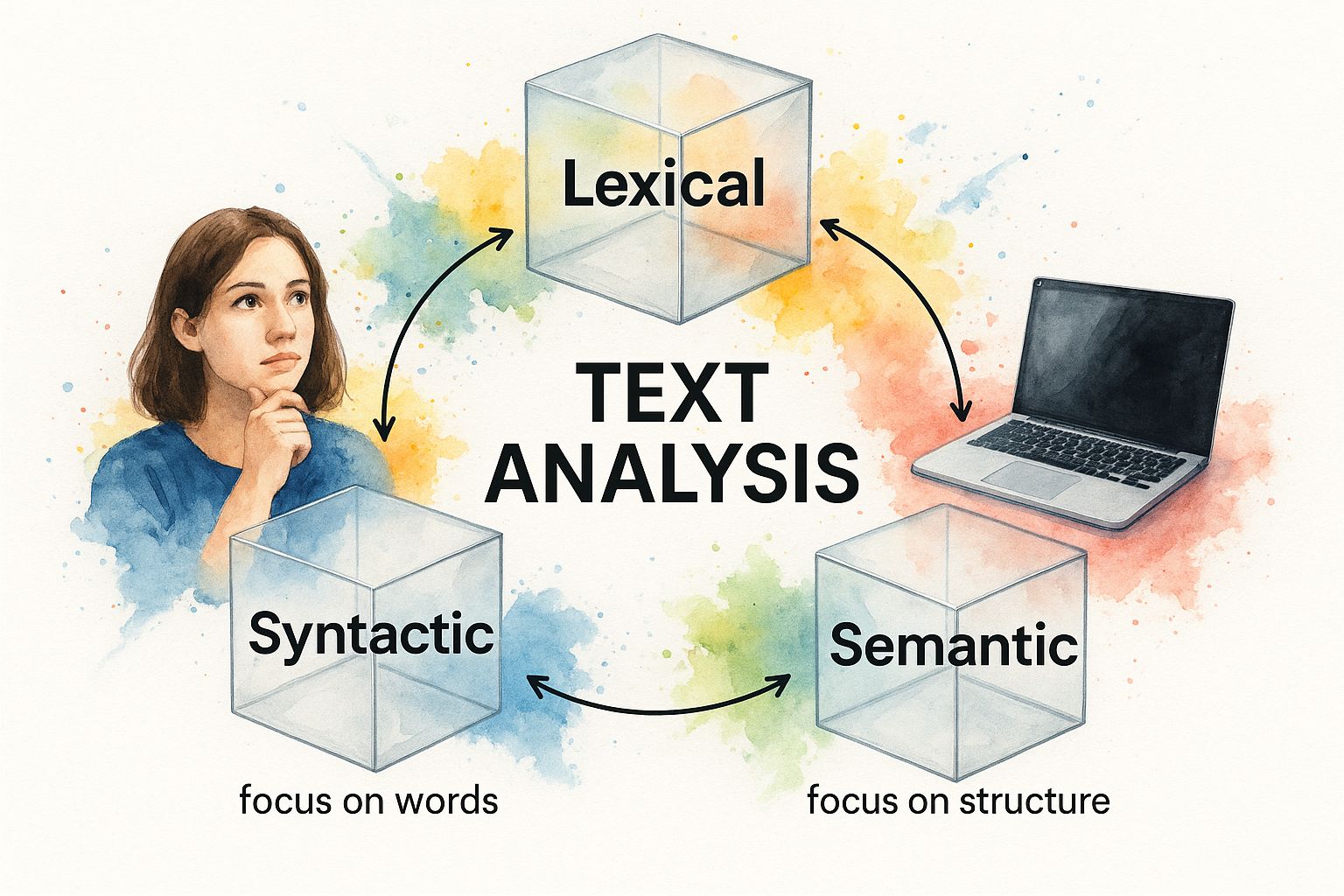What Is Text Analysis? A Founder's Guide to Not Going Broke.
Learn what is text analysis from a founder's perspective. Turn customer feedback from unstructured noise into a scalable, revenue-driving machine.
Posted by
Related reading
10 Voice of Customer Examples You Can Actually Use
Stop guessing. See 10 real voice of customer examples from surveys, social media, and support tickets to find out what your customers actually want.
A Founder's Guide to Analyzing Survey Data
A battle-tested approach to analyzing survey data. Learn how to turn raw feedback into actionable insights that drive real business decisions.
Customer Advisory Board: The Founder's Playbook for Avoiding Catastrophic Mistakes
A practical guide to building a customer advisory board that provides honest insights, validates your strategy, and prevents costly product mistakes.
You’re sitting on a goldmine and you're too busy shipping features to notice. Every support ticket, every cancellation reason, every angry tweet—that’s not noise. That's your customer base giving you a free, brutally honest roadmap to your next million in ARR. Ignore it, and you'll be lucky to survive the quarter.
Text analysis is how you stop guessing and start listening. It's using a machine to read all that messy, emotional human feedback and spit out cold, hard priorities. It’s the difference between hearing the one loud, annoying customer and seeing the silent, deadly trend that’s about to kill your company.
Your Customers Are Screaming at You—Are You Listening?

This isn't some "customer-centric" platitude you'd hear from a corporate drone. This is about survival. I learned this the hard way when my team nearly lost a six-figure contract because we were blind to a single, recurring complaint buried in hundreds of support emails. The signal was there, screaming at us, but we were too busy admiring our own code to notice. We were building in a vacuum.
Takeaway: Ignore your customer feedback, and your competitor who doesn't will eat your lunch.
The Brutal Difference Between Guesswork and Knowing
Most founders think they have a pulse on their customers because they "skim the support inbox." This is a comforting lie that makes you feel connected while guaranteeing you miss the big picture. You're trying to navigate a battleship by occasionally glancing out a porthole.
| Manual "Skimming" (Founder Delusion) | Systematic Text Analysis (The Edge) |
|---|---|
| Reactionary: You find out about a problem after it’s already causing churn. | Proactive: You spot trends and fix issues before they crater your MRR. |
| Biased: You notice the loudest complaints, not the most expensive ones. | Objective: It’s raw data. It shows you what most users care about, not just the squeaky wheels. |
| Unscalable: Works for your first 10 customers. Fails miserably at 1,000. | Scalable: Analyzes 10,000 data points as easily as it analyzes ten. |
| Gut Feel: You think you know the top issues. | Certainty: You know that 23% of churned users mentioned "confusing UI." |
The manual approach ensures you’ll only notice a problem after it’s already costing you money. Text analysis flips the script. It's not just about collecting feedback—you can learn how to get customer feedback from dozens of sources. It's about systematically dissecting it to find the patterns before they become catastrophes.
Takeaway: Gut-feel is for your first ten customers; data is for your first million in revenue.
So, What Is Text Analysis, Really?
Forget the academic bullshit. Text analysis is having a superhuman intern who reads every single word your customers ever write to you—support tickets, reviews, chats, surveys—and tells you exactly what they’re pissed off about, what they love, and what they’d pay for next. It turns a mountain of unstructured whining and praise into a prioritized to-do list.
It doesn’t just say, "Some customers are unhappy." It says, “15% of support tickets this month mentioned ‘slow shipping times,’ and those customers are churning at twice the normal rate.”
Turning Noise into Actionable Signals
Trying to understand customers by manually reading reviews is like standing in a stadium and trying to understand the game by listening to individual conversations. It’s just noise. Text analysis is the headset that filters out the chatter and highlights the only three things that matter: a bug that’s killing deals, a feature everyone is begging for, or a compliment you can slap on your homepage.
This isn’t just for customer support. It's used for ripping apart legal documents, too. Think legal document analysis and data extraction—same principle, different battlefield. Turn text into a competitive weapon.
Takeaway: Text analysis turns messy customer chatter into a clear, prioritized list of what to fix or build next.
The Tools of the Trade That Actually Work
Forget "neural networks." You don't need a PhD. You need to know the three workhorse techniques that do 90% of the heavy lifting.
Sentiment Analysis: Are They Happy or Pissed Off?
This is your canary in the coal mine. It scans text and flags the emotion: positive, negative, neutral. We once saw a tiny dip in positive sentiment in our app reviews. It felt like nothing. Two weeks later, churn was up 1.5%. The unhappy customers were whispering before they started shouting. Sentiment analysis let us hear them.
Takeaway: Sentiment analysis is your early warning system for churn. Ignore it, and you're choosing to be surprised when revenue drops.
Topic Modeling: What Are They Actually Talking About?
Okay, 15% of users are unhappy. So what? Topic modeling tells you why. It’s a machine that sorts a giant, messy pile of LEGOs into perfectly organized bins: "slow app performance," "confusing pricing," "requests for dark mode." It finds the signal in the noise. We used it to uncover a feature request hiding in plain sight. We built it. It became our next big growth driver.

Entity Recognition: Who or What Are They Mentioning?
This is your competitive intelligence weapon. It automatically finds specific names and products in the text. This is gold.
- Competitors: Customers mentioning a rival's feature they wish you had? That’s your product roadmap, gift-wrapped.
- Your Features: They complaining about "the dashboard" or "the export function"? Now you know exactly where to point your dev team.
- People: They praising a specific support agent? That’s an employee you need to promote, yesterday.
No wonder the text analysis market is set to hit $12.37 billion by 2029. Your competitors are already doing this. read the full research on this explosive growth.
Takeaway: Master Sentiment, Topic, and Entity analysis. These three will give you 90% of the insight with 10% of the bullshit.
Stop Admiring the Problem and Start Making Money
A dashboard filled with pretty sentiment charts is a vanity metric. It’s business masturbation. The only reason to do text analysis is to make a decision that leads to more money or less churn. Anything else is a waste of runway.
Weaponize Your Competitors' Failures
Your competitors are getting trashed on G2 and Capterra. Are you listening? We scraped every one-star review for our main rival. The insight wasn't "people hate their support." Useless. Text analysis showed the specific phrase was “three-day wait for a response.”
Our new headline: “Live Support in Under 60 Seconds.” We ran ads targeting their brand name with that copy. Demo requests jumped 18% the next month.
Takeaway: Your competitor’s one-star reviews are your best marketing copy. Text analysis finds the exact words to use.
Turn Sales Calls into Product Specs
Your sales call transcripts are a goldmine. We started transcribing every call and running analysis to spot feature requests. But here’s the kicker: we cross-referenced every request with the deal size in our CRM. A request for "Salesforce integration" from a dozen small-fry prospects is noise. The same request from three potential enterprise clients worth $50k ARR each? That's a blaring siren telling you exactly what to build to unlock your next revenue tier.
Takeaway: Your sales calls aren't conversations; they're blueprints for your next killer feature.
Get Ahead of Churn Before It Happens
Waiting for your monthly churn report is like waiting for an autopsy. The patient is already dead. We set up an alert: notify us if negative sentiment about “speed” increases by more than 10% in 48 hours. The alarm went off. A third-party API we used had degraded. We communicated it to users before they noticed. We didn't just prevent churn; we built trust by admitting a problem before they had to report it.
Takeaway: Don't just analyze what customers are saying; use their exact words to build your product, write your marketing, and save your company.
Bad Habits That Will Sabotage Your Efforts

A great tool just helps you make mistakes faster if your habits suck. This isn't about technology. It's about discipline.
Confirmation Bias Mining
This is the most dangerous trap: diving into feedback not to learn, but to prove you were right all along. You ignore the 50 tickets about a critical bug to focus on the three requesting that niche feature you wanted to build. This is intellectual dishonesty, and it will tank your company. You're using a heat-seeking missile and aiming it at your own feet.
Takeaway: If the data doesn’t make you profoundly uncomfortable once a month, you’re doing it wrong.
Analysis Paralysis
The second deadly sin is obsessing over perfect data instead of acting on good enough insights. You don't need a 99.9% confidence interval to make a call. If you see a spike in negative sentiment after a launch, you don’t need a peer-reviewed study to tell you there’s a fire. While you're polishing charts, your competitors are shipping.
Takeaway: Speed is your biggest advantage. Don't trade it for academic precision that doesn't matter.
Delegating Without Context
I once told a junior dev to "find trends in our support tickets." He came back thrilled about a spike in mentions of an integration. We spent a month scoping an overhaul. Then a senior engineer asked, "Didn't we just send a 3-part email campaign about that integration?" The "trend" was an echo of our own marketing. We wasted a month chasing a ghost because the analyst lacked business context.
Takeaway: Never delegate analysis to someone who doesn't understand the strategy behind the numbers.
Your No-Nonsense Starting Plan
Enough theory. Here’s a 30-day plan. No expensive software. No data scientists. This is about scoring a quick win.
Week 1: Feel the Pain. Don't buy anything. Manually read and categorize your last 100 negative reviews or support tickets. Yes, it will suck. That's the point. You need to viscerally understand the problem before you throw tech at it.
Week 2: Pick One Source, One Goal. Connect one data source to a tool with a free trial. Your only goal: automatically find the top 5 most frequent complaints. The text analytics market is projected to hit $28.19 billion by 2029 for a reason. Read more on the market trends shaping this industry. Get your piece.
Week 3: Share One Brutal Insight. Find the single most painful finding. Boil it down to one sentence. Post it in Slack. Something like: "Customers who mention 'slow' are 3x more likely to churn in the next 60 days." Make it impossible to ignore.
Week 4: Make One Damn Decision. Take that insight and act on it. Change a line of copy. Prioritize one bug fix. Tweak an onboarding email. Close the loop. Prove this isn't an academic exercise.
Takeaway: Your goal in month one isn't mastery; it's getting one small, data-driven win to prove this works.
The One Thing Everyone Gets Wrong About Text Analysis
The biggest misconception is that text analysis gives you answers. It doesn’t. It gives you better, more expensive questions.
A worthless analysis concludes, "20% of customers are unhappy with pricing." An insightful one forces you to ask, "Why are these specific customers unhappy? What exact language do they use right before they churn? Is the problem the price, or is our value prop just not connecting?" Stop looking for a magic bullet. The real job is to arm your team with the sharp questions they should have been asking all along.
Takeaway: Stop looking for answers. Use analysis to find the questions that are expensive to ignore.
Stop guessing what your customers are trying to tell you and start building your roadmap to revenue with Backsy.